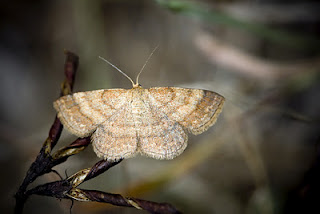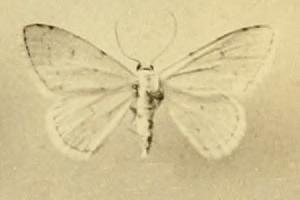
The geometer moths are moths belonging to the family Geometridae of the insect order Lepidoptera, the moths and butterflies. Their scientific name derives from the Ancient Greek geo γεω, and metron μέτρον "measure" in reference to the way their larvae, or inchworms, appear to measure the earth as they move along in a looping fashion. A very large family, it has around 23,000 species of moths described, and over 1400 species from six subfamilies indigenous to North America alone. A well-known member is the peppered moth, Biston betularia, which has been subject of numerous studies in population genetics. Several other geometer moths are notorious pests.

Rhodometra sacraria, the vestal, is a moth of the family Geometridae. The species was first described by Carl Linnaeus in his 1767 12th edition of Systema Naturae.

Scopula is a genus of moths in the family Geometridae described by Franz von Paula Schrank in 1802.

Scopula rubiginata, the tawny wave, is a moth of the family Geometridae. The species was first described by Johann Siegfried Hufnagel in 1767.

Scopula ternata, the smoky wave, is a moth of the family Geometridae. It was described by Franz von Paula Schrank in 1802. It is mainly found in northern and parts of central Europe and in isolated populations in southern and south-eastern Europe. Its western range is eastern France, eastern Belgium and Scotland, with an isolated population in the Pyrenees. In the north its range extends to the polar regions and in the south it is found up to the Alps. Its eastern range extends through central and northern Russia up to the Ural, through Siberia up to the Yenisei River.

Scopulini is a tribe of the geometer moth family (Geometridae), with about 900 species in seven genera. The tribe was described by Philogène Auguste Joseph Duponchel in 1845.

Scopula turbidaria is a species of moth in the family Geometridae. It is found in France, Spain and Portugal. It is also found in North Africa.

Scopula lactaria is a moth of the family Geometridae. It was described by Francis Walker in 1861. It is found in Africa south of the Sahara and on some islands of the Indian Ocean. It can be distinguished from Scopula minorata only by genitalia examination.
Scopula addictaria is a moth of the family Geometridae. It was described by Francis Walker in 1861. It is found in Sri Lanka.
Scopula alba is a moth of the family Geometridae. It is found in France, Italy and on Sicily and Corsica.

Scopula rufomixtaria is a moth of the family Geometridae. It is found in France and on the Iberian Peninsula.
Scopula asellaria is a moth of the family Geometridae. It was described by Gottlieb August Wilhelm Herrich-Schäffer in 1847. It is found in southern Europe and North Africa.

Scopula beckeraria is a moth of the family Geometridae. It was described by Julius Lederer in 1853. It is found in Italy, Croatia, North Macedonia, Greece, Bulgaria, Romania, Ukraine, Russia, Turkey, Armenia, Israel, Lebanon, Iran, Turkmenistan and Kazakhstan.

Scopula submutata, the Mediterranean lace border, is a moth of the family Geometridae. It is found in southern Europe, North Africa and the Near East. The habitat consists of open, dry grassland and rocky slopes.
Scopula pratana is a moth of the family Geometridae. It is found in North Africa, the Canary Islands, the Near East and Yemen.

Scopula sacraria is a moth of the family Geometridae. It is found on Cyprus and the European part of Russia.
Scopula scalercii is a moth of the family Geometridae that can be found in central and southern Italy.
Scopula uberaria is a moth of the family Geometridae. It was described by Zerny in 1933. It is found on Cyprus and in the Near East.
Scopula semitata is a moth of the family Geometridae. It was described by Prout in 1913. It is found in the Levant.
Scopula terminata is a moth of the family Geometridae. It is found in Afghanistan, Pakistan and China.










